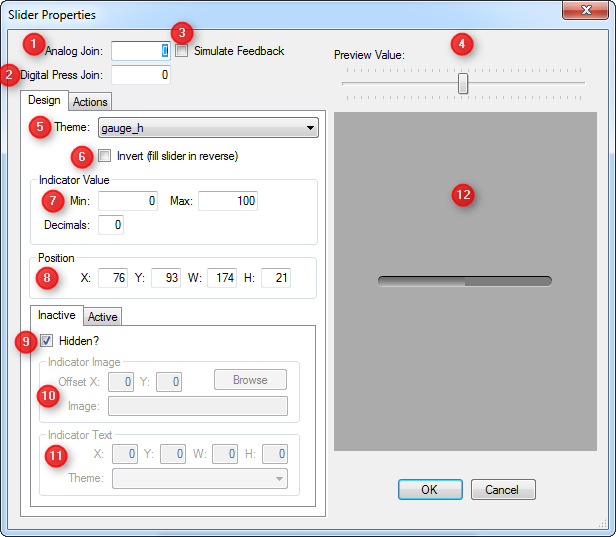User Tools
Sidebar
Navigation
software:gui-designer:sliders
This is an old revision of the document!
Table of Contents
Sliders
Sliders are much like Gauges, except they also allow for interaction by the user (rather than just showing a level).
To implement a slider in guiDesigner:
- Select the slider icon
 on the tool bar.
on the tool bar. - Then draw a box roughly the size of the slider you wish to use. This size can be edited later on.
- You will then need to add a theme to the slider. To do this, select a slider theme from the Theme Library and drag it onto the slider you just added.
You can also drag a slider theme directly from the Theme Manager or Theme Library onto an empty spot on an open page, and the slider will be automatically created at the drop point and assigned the theme you dragged.
Whats the difference between a gauge and a slider?
Good question! A gauge takes a reading from a device/system, and displays the level as a visualisation. A slider is a control that the user can manipulate to change the level of the device/system.
Slider Properties
To access the slider properties, right click on the slider and choose Slider Properties.
Slider Properties Design Tab

1 - Analog Join
The analog join assigned to a slider is used to adjust the slider level. Analog joins have a range of 0 to 65535, which is represented in a gauge as 0 = slider empty, 65535 = slider full.
By default the slider will be assigned an analog join of zero. Before the slider can show any feedback in the form of the slider level, it must be assigned an analog join above zero.
2 - Digital Press Join
3 - Simulate Feedback
When a slider is set to simulation mode, it will change state when manipulated. If simulation is not enabled on the slider, the slider will only change state when it's assigned digital join changes state. If the button is assigned a digital join, the join state will also change when the slider state changes, resulting in other GUI objects using the same digital join to be affected also.
4 - Preview Value
Use this slider to change the slider fill level in the preview window.
5 - Theme
Select the slider theme you would like to use. This choice is derived from the gauge/slider themes you have defined in your project within the Theme Manager.
6 - Invert
Check this box to fill the slider in reverse. E.g. fill the slider from the right to left (or from top to bottom in the case of a vertical slider).
7 - Indicator Value
8 - Position
This option allows for manual entry of the position and size of the slider.
- X Position (left of slider)
- Y Position (top of slider)
- Width of the slider
- Height of the slider
The width and height of a gauge determines if the gauge is rendered in horizontal or vertical mode. When the height is greater than the width, the gauge will render in vertical mode (filling bottom to top). Otherwise, it will be deemed a horizontal gauge (filling left to right).
9 - Inactive/Active Tab - Hidden?
Options 9 - 11 cover both the Inactive and Active tabs as they have the same configurable properties. Choose which tab you want to edit. Inactive will allow you to edit the slider in its non-pressed state. Active will allow you to edit the button in its pressed state.
10 - Inactive/Active Tab - Indicator Image
11 - Inactive/Active Tab - Indicator Text
12 - Preview Window
This windows shows how the slider will look in your GUI, showing the value as set in the Preview Value.
software/gui-designer/sliders.1363828994.txt.gz · Last modified: 2013/03/21 01:23 by aaron
